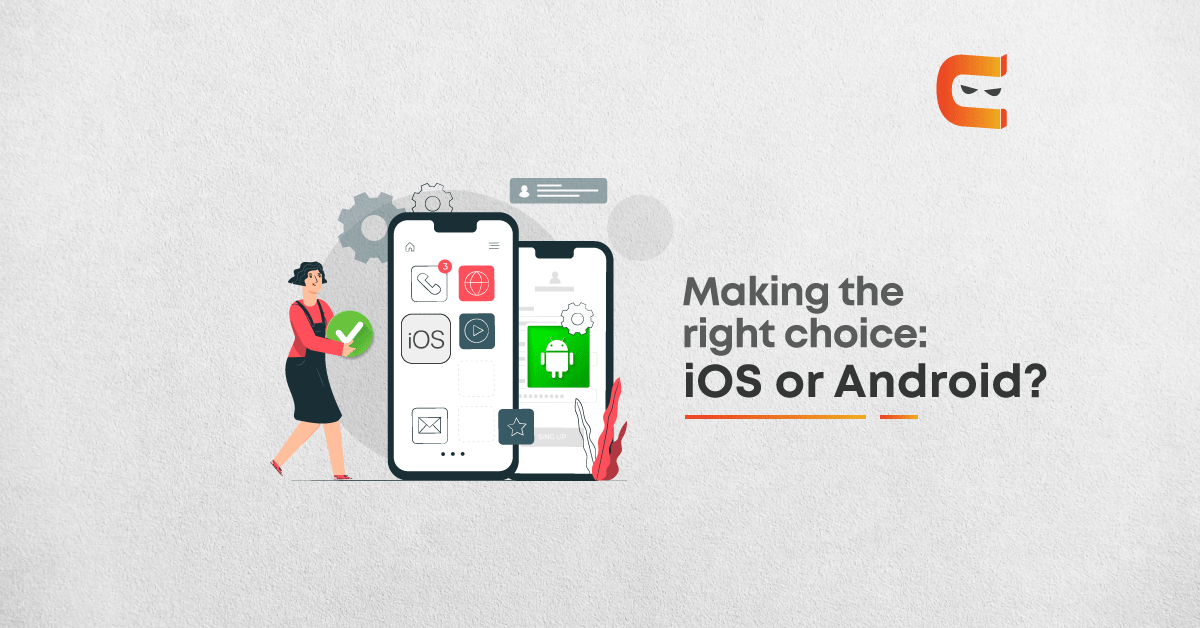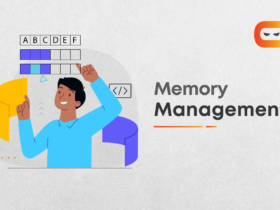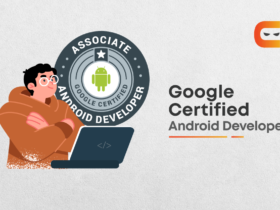Being a beginner in Android Development you must have often wondered that Android has a higher demand or iOS.
Currently, all the top-notch smartphones ruling the market belong to the Android domain or the iOS domain. The other smartphone manufactures like Microsoft, BlackBerry, Canonical, Ubuntu Linux’s parent company, have been silent for quite a long period. Apparently, they have given up on smartphone manufacturing. Hence, we can conclude that the options available are Android smartphones and iPhones.
Well, we don’t intend to start any debate or argument. Being a developer you need to consider all the demands of the client before making the SRS document, for that you need to figure out that the target audiences of the project are Android users, iOS users or both.
Most of us have our hands on Java, but codes are written in java support Android operating system only. Earlier, resources and platforms for iOS development very sparse, but now we have a large number of iOS development languages like Kotlin, Swift, and so on. Now, you can even opt for two-fold strategies such as using a cross-platform application development tool like Ionic-Cordova, Flutter, React Native, etc.
You cannot jump into any conclusion, before considering the requirement of the consumers as the entire revenue of your project depends on the customer response and review. If your motive is to create a social application then your aim should be to maximise the number of users, whereas if you creating any luxury app you can aim for a smaller set of opulent audience.
Let’s compare Android and iOS on the basis of eight significant aspects:
Financial Constraints:
You must never forget that any application or new technological advancements should be free from severe financial constraints, i.e. if the technology is cheap then automatically more and more users will avail it. But, if the software or device is expensive, only a bunch of fortunate people will avail this. Apple has been at the polar region when it comes to pricing, the cheapest reported price of an iPhone SE at the rate of $400. Casual iPhone prices: the starting price of iPhone 11 being $700, iPhone 11 Pro Max being $1,100 and the starting price of iPhone X was $1,000, which was considered to a revolutionary descent in the price.
In terms of scalability and variety, none and compete with Android. If you want to go for any high profile phone we can go for Samsung’s latest Z series which has an average cost of $1,400.Android comes with many optimal smartphones that can perform most of the essential functions and cost only around $100 and offers a wide chain of free applications. Thus, attracting and supporting the budget-conscious mass.
Points Credited: Android
Applications and App Store
Let us begin with contrasting the present-day statistics of Android and iOS applications.
- Android Apps: 2.96 million
- iOS Apps: 2.2 million
The difference can be roughly estimated as a million. Honestly, numbers are not suitable metrics for analysing the utility as users use only a handful of apps, an average person has only fifty applications on his mobile phone and the widely used applications are usually cross-platforms. Conventionally, iOS has been a more inviting platform for developers, and we can see contemporary applications first on iOS. The Play Store has a higher number of free apps. But iOS has got better mobile games and advanced applications. Apple’s App Store provides a better browsing experience and customised recommendations to the users. Apart from this, the App Store has reliable security protocols and curation libraries also. We have to pick quality over quantity, thereby; iOS wins the league in this case.
Points Credited: iOS
Battery Life
This aspect is very much nested as Android phones are very diverse. The reason behind bad reviews of any smartphone is its short battery life. However, nowadays Android devices come with a battery specification of 4000-5000 mAh.It is difficult to compare Android and iOS on this ground as none of the models is correspondent, they have been launched in a different time-span with different hardware designs. Analogous to Android, iOS also provides the feature of power-saving mode, to save the battery life by restricting the unnecessary threads.
Before the ingress of Apple’s iPhone 11, iPhone X, and even the iPhone SE (2020), Android had an upper-hand in terms of swift and wireless charging. But iPhone managed to stand at par with Android.
Points Credited: Android and iOS
Cloud Integration
The main reason for the creation of the Cloud is to have a centralised database. But iCloud is very much restricted as we can access iCloud only from Apple devices. Many iPhone users have reported their unpleasant experience while working with iCloud. Android’s integrated with Google Cloud allows enjoying the benefits of Google Apps like Google Photos, Google Sheets that can be accessed from any random device. All in all, Android is superior here, as it is backed by the Google Cloud Services that allow unlimited storage and recommendations based on predictive analysis.
Points Credited: Android
Prompt Updates
iOS beats Android distinctly when it comes to updating the software on a regular basis. When Apple launches a new update or feature set, all the pre-existing devices are also updated. This is not true in case of Android, mostly Android updates have hardware requirements also, so if you want to avail the updates, you will have to procure a new device.
Seventy per cent of iOS devices are currently functioning with the latest operating system. Conversely, for Android, in spite of the launch of Android 11.0, only eight per cent of the devices are running on Android 10.0. This implies that the major portion of the population is still using outdated versions due to the heavy hardware requirements.
Points Credited: iOS
Customisability
This has been one of the most developer-friendly features of Android since its advent. You can re-design your phone by yourself; you may install additional theme-based applications from the Google play store to give a contemporary look to your application. It has many options for layouts, widgets, shortcuts, themes, wallpapers, icons and the overall user-interface.
Although you can alter the backdrops in iOS, the support for aligning widgets are too restricted, exponentially lower than Android. The use of third-party applications for manipulating the user-interface is forbidden in iOS. If you want things according to your choice, or you are very much influenced by the colour and design of your user-interface, then you must opt for Android as it comes with more than five hundred applications for user-interface customisation.
Points Credited: Android
Accessibility
It is often said that the overall user-interface of Android is more complicated than that of iOS. But both of these offer a certain range of accessibility features to the user. There are several apps on iOS and Android that are specially designed for the elderly.
If you are looking for a customised device for someone elderly or a tech-geek then Android can offer you better and specific options. Samsung recently launched its easy-mode that makes the buttons and fonts huge and simplifies the entire user experience or Android is compatible with a huge bucket of third-party apps, so may go for any of them.
Eventually, iOS has a simpler and easy-to-use user interface significantly. The iOS user-interface is common to all the iPhones, whereas in Android it varies from manufacture to manufacturer. We can also say that iOS is more streamlined and less cluttered than Android, this makes it more accessible.
Points Credited: iOS
Security
Both Android and iOS offer decent security and safeguarding. From the perspective of an Android user, he never encounters any security issues as he never goes out of the Google Play Store to install applications. However, Android lags behind in security, as it lags behind in updates. The earlier versions of Androids are significantly vulnerable to grave hacks like Heartbleed and Stagefright.
Regular update in the security domain is vital as security breaches are becoming more widespread these days. Apple is also deep-rooted in the market with its security protocols, even at the consumer level. The Touch ID and FaceID in the iPhone X and later are worth noting. Apple encrypts data in iMessage and its other apps. Apple was even engaged in an argument with the FBI to guarantee user’s right to encryption. No other OS can match iOS in terms of security until now.
Points Credited: iOS
In the end, we suggest you learn cross-platform application development so that you can work both as an Android or iOS developer. The league between iOS and Android has sustained for years and is still on, so the best option is to adopt a two-fold strategy. As a developer, you should invest your time and resources in learning languages like Kotlin, Flutter or React Native, so that you fit in Android as well as iOS projects.
To explore more about mobile development, click here.
By Vanshika Singolia















Leave a Reply